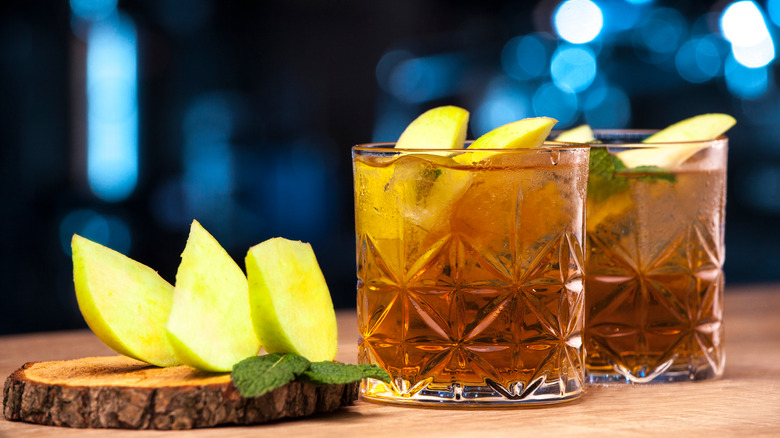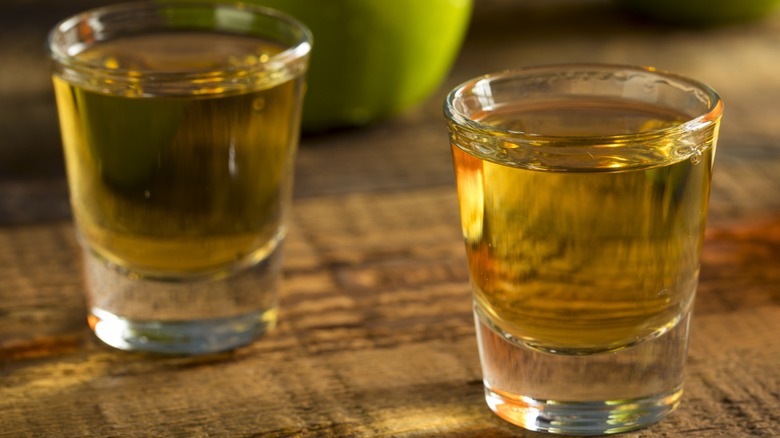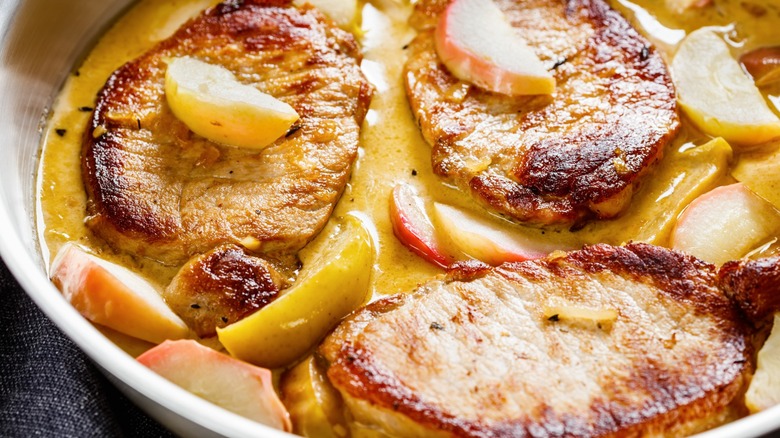What Is Apple Whiskey And What's The Best Way To Use It?
When magazine cover recipes shift towards cozy braises and soups, it's a sure sign that apple season is in full swing. Apples become a prominent ingredient in apple desserts like cakes, galettes, pies, and even cocktails like apple cider and bourbon during fall. The robust notes of dark spirits like whiskey and rum pair perfectly with the crisp apple flavors and mixologists and spirit brands actively create beverages that combine these complementary flavors.
Apple whiskey has emerged as a popular addition to the flavored spirit section of your local liquor store, offering an easy way to infuse the refreshing taste of autumn into your drinks. In the world of bottled whiskey, you'll come across a variety of brands offering apple-infused options, each with a unique level of sweetness and a distinctive method for infusing that fruity essence into its product. These apple whiskies cover a spectrum of flavors, from the tang of green apples to the sweetness of caramel apples and even the spiciness reminiscent of apple pie. This diversity of flavors provides a wide range of choices for enthusiasts to discover and enjoy.
How apple whiskey is made
Every distiller has its own unique approach to flavoring whiskey, but one common technique is adding sugar to enhance and balance the flavors. In the lower price range, you might encounter whiskeys that use artificial apple flavors, which is reminiscent of the sweetness found in Jolly Rancher candy. These options tend to be very sweet and are often best suited as a sugary element in cocktails rather than for sipping over ice. With sweeter bottles, the actual whiskey flavors can be somewhat concealed, making them taste more akin to a high-proof apple liqueur.
Other distillers opt to use fresh apple juice or apples infused with a subtle amount of sugar, which is then aged alongside the whiskey to create a unique product. These spirits fall in the mid-sweet category, featuring the fresh and vibrant flavors of green or red apples. Ideal for both cocktails and sipping, these versions allow the whiskey's distinct flavors to shine through, providing a well-balanced and refreshing taste.
It's crucial to understand that apple brandy, sometimes referred to as applejack, differs from apple whiskey. Apple brandy is produced through the distillation of apple juice or cider, and it remains unsweetened, without any blending with whiskey. During the distillation process, the apple flavor becomes more subdued as it ages due to the alcohol's heat, resulting in a taste that's quite different from the sweet, apple-forward profile of apple whiskey.
Putting a bottle of apple whiskey to good use
As you might expect, apple whiskey is an excellent choice for crafting cocktails. By using it as a substitute for traditional whiskey in classic drinks like the old fashioned or hot toddy, you can create a version with the crisp flavors of fall. The natural sweetness of apple whiskey can even stand in for some of the sugar typically used in these recipes, so begin with a smaller amount and adjust to your taste as you go.
Apple whiskey would not be out of place in a classic whiskey sour, either. You'll find mixologists creating specialty drinks with the spirit as well – a great source of inspiration is the website of your favorite apple whiskey maker. Apple whiskey also proves to be a valuable companion in the kitchen. A splash can enhance the flavors of a reduction sauce for grilled chicken or pork dishes, and it can be used to craft a flavorful whiskey-based glaze for barbecued foods.
When preparing fall-inspired treats like bread pudding or apple pie, simply tossing the apples with a touch of this spirit can add depth to the flavors. You can even use a splash of apple whiskey to infuse an apple note into whipped cream to top those baked goods. So, think of apple whiskey as your fall flavor companion for adding whiskey-soaked apple flavors not just in the glass, but also into your sweet and savory recipes.


